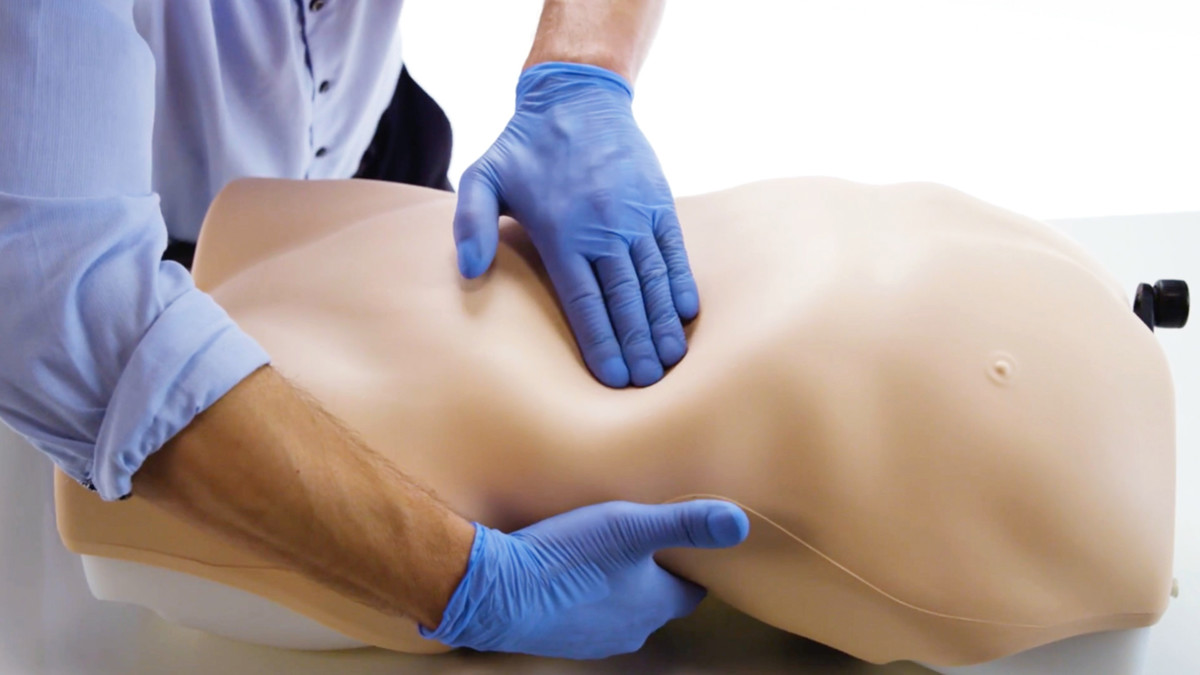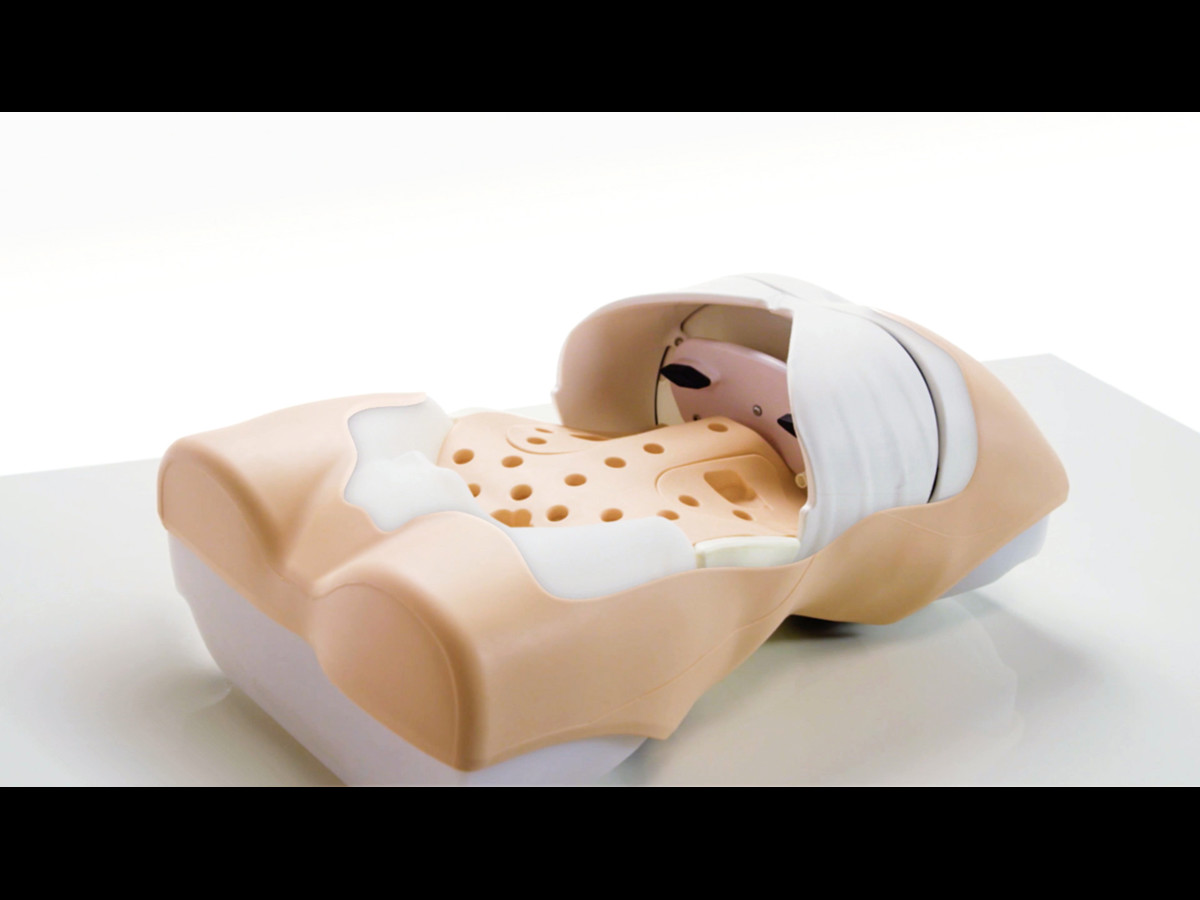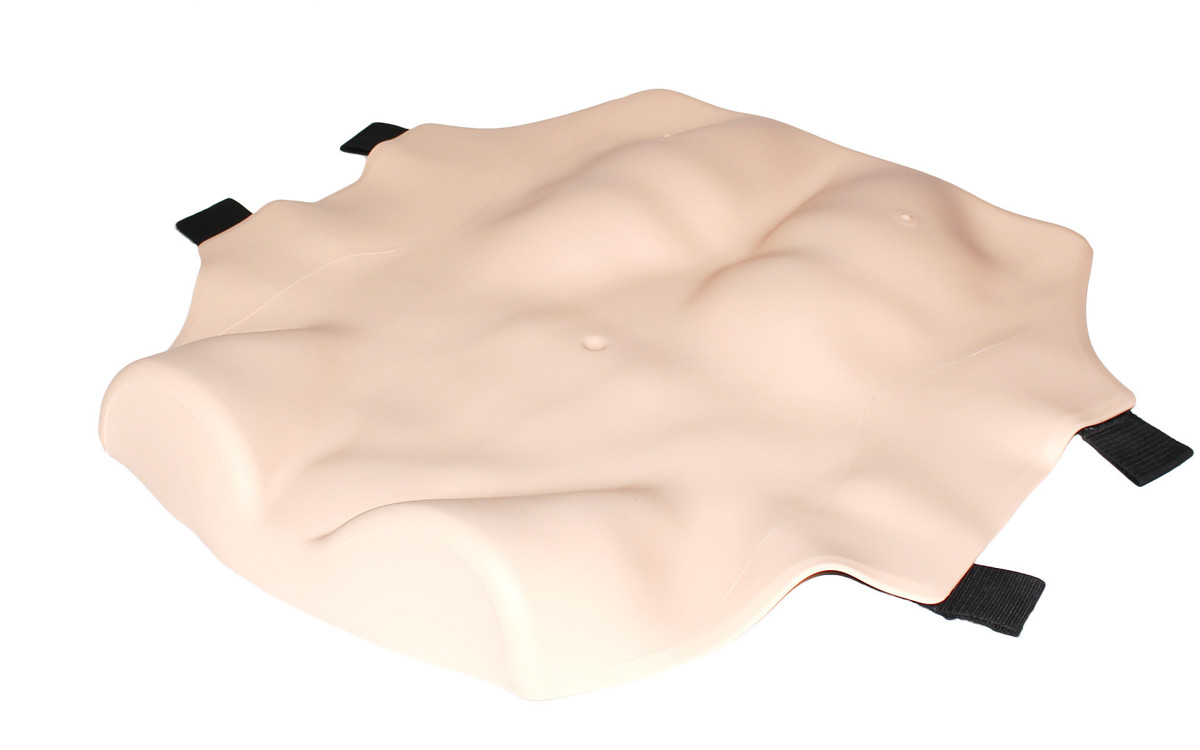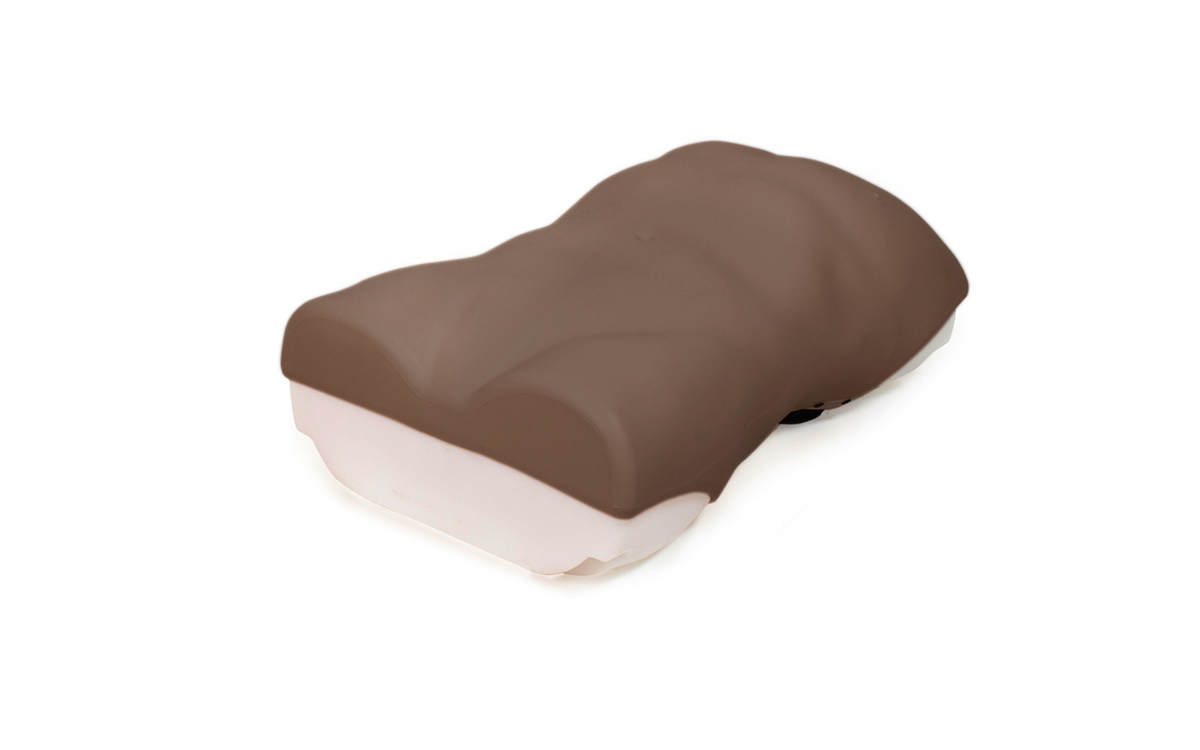




















Abdominal Examination Trainer (Light Skin Tone)
Skin Tone
Now with Augmented Reality training mat and FREE Limbs AR app.
Adding to cart...
Added to cart
Sorry, something went wrong adding the product to the cart.
Limbs & Things’ Abdominal Examination Trainer represents an anatomically accurate adult torso featuring abdomen, pelvis and lower part of thorax along with key bony landmarks.
Augmented Reality is now an integral part of Abdominal Examination training
The Augmented Reality Mats help combine real world MRI and CT scan data, with the skills of talented medical artists and digital creators, to bring the internal anatomy of our trainers to life.
Within the L&T AR app’s digital environment, you can move around your task trainer and view various overlays, including: the musculature, organs and vessels, and skeletal structure. The interface allows you to move seamlessly between the layers, as well as view their cross sections.
Limbs & Things’ Abdominal Examination Trainer represents an anatomically accurate adult torso featuring abdomen, pelvis and lower part of thorax along with key bony landmarks.
Augmented Reality is now an integral part of Abdominal Examination training
The Augmented Reality Mats help combine real world MRI and CT scan data, with the skills of talented medical artists and digital creators, to bring the internal anatomy of our trainers to life.
Within the L&T AR app’s digital environment, you can move around your task trainer and view various overlays, including: the musculature, organs and vessels, and skeletal structure. The interface allows you to move seamlessly between the layers, as well as view their cross sections.
Students are also able to view digital procedures in the AR environment to see how the procedure is done, and its impact on the patient’s anatomy.
The Abdominal Examination Trainer is ideal for OSCE preparation and assessment, as our torso model enables trainees to practise the required techniques of palpation, auscultation and percussion elements of abdominal, or gastrointestinal (GI) examination.
The trainer comes with interchangeable pathological organs and tissue masses, including a variety of livers, spleens, abdominal aortas and various masses, that can all be quickly inserted on to the abdominal organ locator. Gaseous distension and ascites can also be simulated, providing the correct feel during symptom-based simulation.
The Abdominal Examination Trainer is also equipped with a built-in MP3 and has a memory stick with 3 pre-recorded audio sounds which are played at various locations in the abdomen and heard during auscultation with a stethoscope.
Overview
- Augmented Reality capabilities with the Limbs AR Mat
- Trainer or Simulated Patient can vary the respiratory movement of liver and spleen
- Built in MP3 with 3 pre-recorded audio sounds on a memory stick that can be heard at various locations in the abdomen during auscultation with a stethoscope.
- Volume of bowel sounds can be adjusted, to extend the learning experience and hone trainees’ auscultation skills.
- The distension set allows for realistic checking for ascites using percussion, shifting dullness or fluid thrill technique, and simulation of bowel obstruction on percussion and auscultation
- The pulse bulb allows simulation of normal and aneurysmal aortic pulse
Realism
- Contains both normal and abnormal pathologies of organs that react realistically under palpation and respond appropriately to percussion
- Lifelike quality of abdominal skin accommodates for gaseous distension and ascites simulation
- Realistic ballottement of enlarged kidney
Versatility
- Removable abdominal skin allows for quick and easy changeover of organs during training
- Suitable for both benchtop use and hybrid use with a Simulated Patient
- Model can be rolled onto its side for examination of ascites and shifting dullness
- Can be powered using AA batteries or by mains power cable.
Cleaning
- Clean skin surface with soft, damp cloth and mild detergent
Safety
- This product is latex free
- Weight of model is within male and female health and safety limits for lifting to chest height
- In the unlikely event that the Ascites Bag splits all affected product parts should be wiped down before continuing use.
Anatomy
- Representation of lower thoracic and lumbar spine
- Torso featuring abdomen, pelvis and lower part of thorax
- Bony landmarks include ribs, costal margin, xiphisternum, pubic crest and anterior superior iliac spines
- 3 Livers: slightly enlarged, enlarged with smooth edge and enlarged with irregular edge
- 2 Spleens: slightly enlarged and markedly enlarged
- 2 enlarged Kidneys
- Distended Bladder
- 2 Aortas: normal and aneurysmal
- Set of 6 Abdominal Pathologies including 4 smooth masses and 2 irregular hard masses
- Distension Set including Ascites bag, Gaseous Distension Bag, Pump and Foam Insert
Skills Gained
- Familiarity with the regions and underlying abdominal anatomy of an adult patient
- Practice in abdominal palpation, auscultation and percussion
- Ability to recognize and differentiate a range of abnormal organs and pathologies
- Identification of ascites, specifically shifting dullness and fluid thrill
- Identification of gaseous distension and bowel obstruction
- Ballottement of kidneys
- Professional-to-patient communication (when used with a Simulated Patient)
Product Contains

Augmented Reality Mat for Abdominal Examination
-
Light
-
Dark

Abdominal Examination Skin (Light Skin Tone)

Abdominal Rectus Bag

Abdominal Examination Organ Locator

Abdominal Wall

Abdominal Examination Livers (Set of 3)

Abdominal Examination Spleens (Set of 2)

Abdominal Examination Kidneys (Set of 2)

Abdominal Examination Bladder

Abdominal Examination Pathologies (Set of 6)

Abdominal Examination Aortas (Set of 2)

Abdominal Examination Distension Set

Abdominal Examination Ascites Bag

AE Speaker

International 5v DC Power Supply
Also contains: Abdominal Examination Base Unit (Product No. 60005)
Works with the following products:
References
National Organisation of Nurse Practitioner Faculties, Nurse Practitioner Core Competencies Content, 2017 Independent Practice Competencies p.14 3.b Uses advanced health assessment skills to differentiate between normal, variations of normal and abnormal findings. 3.c Employs screening and diagnostic strategies in the development of diagnoses.
SCORE Curriculum Outline for General Surgery (2017-18): p.6 Category 1: Abdomen - General Diseases/Conditions • Abdominal Pain - Acute • Abdominal Pain - Chronic • Ascites • Bacterial Peritonitis - Spontaneous • Peritoneal Neoplasms - Carcinomatosis p.9 Category 4: Abdomen - Liver Diseases/Conditions • Hepatic Mass - Evaluation
NASEMSO National Model EMS Clinical Guidelines September 2017 Version 2.0, p.48 Abdominal Pain Pertinent Assessment Findings 1. Rebound tenderness 2. Guarding 3. Abdominal distension 4. Abdominal tympany to percussion 5. Tenderness focal to a specific abdominal quadrant 6. Presence of “pulsatile” abdominal mass
AAMC (2008) - Recommendations for Preclerkship Clinical Skills Education for Undergraduate Medical Education , p/26 Appendix 5: Patient Examination. Describe abdominal findings. Perform light and deep palpation. Demonstrate tests for peritoneal irritation. Describe the liver span. Palpate for liver and spleen. Show how to detect ascites
CPMEC Australian Curriculm Framework for Junior Doctors v 3.1, 2012, p.7: History and Examination: Performs a comprehensive examination of all systems; Elicits symptoms & signs relevant to the presenting problem or condition. Discriminates between the possible differential diagnoses relevant to a patient's presenting problems or conditions
RACGP Curriculum for Australian General Practice 2016, CS16 Core Skills unit, p.23 CS2.2.2.2a Demonstrate appropriate and respectful physical examination technique CS2.2.2.5a Identify situations where physical examination findings are inconsistent with history CS2.2.2.2b Effectively utilise appropriate clinical tools to optimise examination CS2.2.2.3b Effectively summarise key examination findings for the patient
Paramedics Australasia Australasian Competency Standards for Paramedics, 2011, p.9 2.a.2 Select and use appropriate assessment techniques Undertake a focussed clinical examination that is consistent with the chief complaint and medical history
Medical Deans' Clinical Assessment Blueprints for the medical graduate 4. Conducts ... organ(s)/system specific physical examination as appropriate. 5. Integrates the information obtained to arrive at an appropriate diagnosis and differential diagnosis.
Competence and Curriculum Framework for the Physician Assistant 2012, p 12 and 23 2.3.5 ...Perform a physical examination tailored to the needs of the patient and the demands of the clinical situation, including ...abdominal examination ...The Physician Assistant should be familiar with the following patient presentations and should be able to manage and diagnose: Distension: abdominal GI disturbances including vomiting/altered bowel habit Mass: abdominal Pain: abdominal
Specialty Training Curriculum for Core Medical Training, 2013 p.51 and 77 Abdominal Pain: The trainee will be able to assess a patient presenting with abdominal pain to produce a valid differential diagnosis • Elicit signs of tenderness, guarding, and rebound tenderness and interpret appropriately...assess a patient presenting with an abdominal mass... abdominal swelling or distension to produce a valid differential diagnosis
The UK Foundation Programme Curriculum 2016. p.9: obtains history, performs clinical examination, formulates differential diagnosis and management plan (FPC 11)
RCOG Core Curriculum, Core Module 1: Clinical Skills Perform valid, targeted and time efficient examinations relevant to the presentation and risk factors Abdominal examination Non-pregnant
The Intercollegiate Surgical Curriculum - General Surgery, 2016,p. 49: 3. Acute abdomen assess and provide the early care of a patient presenting with acute abdominal symptoms and signs. This should include localised and generalised peritonitis ... obstruction (small and large bowel – obstructed herniae, adhesions, colonic carcinoma) and localised abdominal pain (biliary colic, non-specific abdominal pain).
Paramedics - College of Paramedics, Paramedic Curriculum Guidance (3rd Edition Revised 2015) p 25 Section C 1.6.5: Conduct a thorough and detailed physical examination of the patient using appropriate skills to inform clinical reasoning and guide the formulation of a differential diagnosis across all age ranges. UK Ambulance Service Clinical Practice Guidelines (2006) "Medical Emergencies in Adults: Abdomen: Feel for tenderness and guarding in all four quadrants, check for bowel sounds."
Outcomes for Graduates 2018, General Medical Council, p.16 Diagnosis and medical management: 14b. safely and sensitively undertake an appropriate physical examination ...interpret findings from physical examinations...synthesise findings from the history, physical and mental state examinations and investigations ... and make proposals about underlying causes or pathology
RCN Competencies - Advanced Nurse Practitioners, 2012, p.4 ...receiving patients with undifferentiated and undiagnosed problems and making an assessment of their health care needs, based on highly-developed nursing knowledge and skills ... such as physical examination
Royal College of General Practitioners Online Curriculum 3.13 Be able to manage primary contact with patients who have digestive problems. Know how to interpret common symptoms in general practice, including dyspeptic symptoms, abdominal pain. Demonstrate a systematic approach to investigating common digestive symptoms.
What is the abdominal examination simulator used for?
Trainees can use the simulator to practice abdominal assessments, also known as gastrointestinal (GI) examinations. Different combinations of this product will help to identify a variety of gastrointestinal pathologies.
What skills can be learnt with the Abdominal Examination Trainer?
The Limbs & Things Abdominal Examination Trainer is ideal for OSCE preparation and assessment, and helps students gain key skills such as:
- Identification of ascites, specifically shifting dullness and fluid thrill
- Identification of gaseous distension and bowel obstruction
- Ballottement of kidneys
- Familiarity with the abdominal regions and underlying anatomy
What scenarios can be set up on the abdominal examination simulator?
Scenarios include:
- Carcinoma or mass in the left iliac fossa
- Liver metastasis
- Lymphoma
- Aortic aneurysm
- Acute urinary retention
- Ovarian cyst
- Enlarged kidneys
How is the Abdominal Examination Trainer powered?
The trainer is run by a mains power cable, however, you can use 4 AA batteries if power is unavailable allowing it to be used in a range of environments.
Can additional sounds be added to the Abdominal Examination Trainer’s MP3 Player?
Yes, on the MP3 player there is an SD slot that can be used to add additional sounds which can be obtained online or recorded to increase variety and realism. The Pre-set options include normal and abnormal bowel sounds and aortic bruits.
Please note: an SD card is not supplied with this trainer.
What is the fluid within the Ascites Bag of the abdominal trainer?
The fluid consists of food grade glycerine which better simulates the feel of a stomach.
Why has the foam insert of the abdominal trainer changed colour?
The Distension Foam insert will naturally darken when exposed to UV light. This does not have any effect on the functionality of the foam.
How can I prevent kinks in the air inlet tube when using the Gaseous Distension Bag?
To prevent kinks, ensure that the air inlet tube is on the underside of the Gaseous Distension Bag and under the Distension Foam.
Can replacement parts be purchased for the Abdominal Examination Trainer?
Yes, replacements are available for all major parts of the abdominal trainer which can be purchased online.





